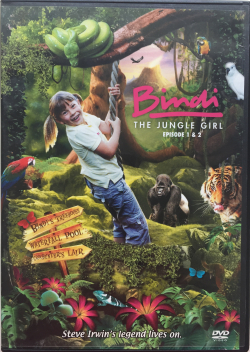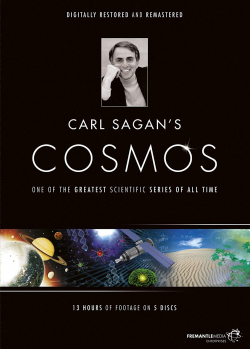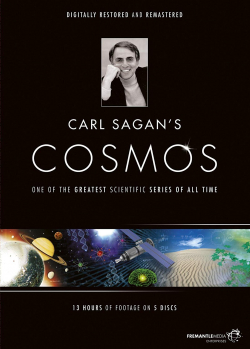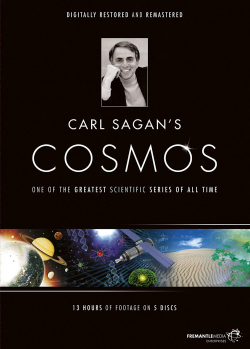Carl Sagan's Cosmos Cosmos - Episodes 1-3
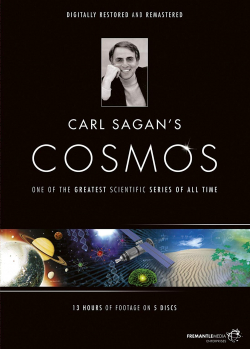
Type
Audio/Visual
Authors
Sagan ( Carl )
Category
DVD - Episode/s of series
[ Browse Items ]
Publisher
Fremantle Media Enterprises, United States
Tags
Series Name
Abstract
Carl Sagan explores the universe in this monumental cosmic journey. A fascinating blend of science, education, and entertainment that covers everything from the cells which build life to the Big Bang that started it all. The cosmos is all that is, ever was, or ever will be... we are, all of us, made of star-stuff.
Cosmos tells the fascinating story of how nearly fifteen billion years of cosmis evolution transformed matter and life into consciousness, of how science and civilisation grew up together and of the forces and individuals who helped shape modern science.
Astronomer Dr Carl Sagan is host and narrator of this amazing 13 hour series, now digitally remaster, restored and enhanced. With topics including the origins of life, the search for extra-terrestrial life, the "greenhouse effect", the lives of stars, interstellar travel and the effects of attaining the speed of light, this is a fascinating insight into humanity and the universe.
Cosmos tells the fascinating story of how nearly fifteen billion years of cosmis evolution transformed matter and life into consciousness, of how science and civilisation grew up together and of the forces and individuals who helped shape modern science.
Astronomer Dr Carl Sagan is host and narrator of this amazing 13 hour series, now digitally remaster, restored and enhanced. With topics including the origins of life, the search for extra-terrestrial life, the "greenhouse effect", the lives of stars, interstellar travel and the effects of attaining the speed of light, this is a fascinating insight into humanity and the universe.
Description
Episode 1: The Shores of the Cosmic Ocean
Carl Sagan opens the program with a description of the cosmos and a "Spaceship of the Imagination" (shaped like a dandelion seed). The ship journeys through the universe's hundred billion galaxies, the Local Group, the Andromeda Galaxy, the Milky Way, the Orion Nebula, our Solar System, and finally the planet Earth. Eratosthenes' successful calculation of the circumference of Earth leads to a description of the ancient Library of Alexandria. Finally, the "Ages of Science" are described, before pulling back to the full span of the Cosmic Calendar.
Episode 2: One Voice in the Cosmic Fugue
Sagan discusses the story of the Heike crab and artificial selection of crabs resembling samurai warriors, as an opening into a larger discussion of evolution through natural selection (and the pitfalls of intelligent design). Among the topics are the development of life on the Cosmic Calendar and the Cambrian explosion; the function of DNA in growth; genetic replication, repairs, and mutation; the common biochemistry of terrestrial organisms; the creation of the molecules of life in the Miller–Urey experiment; and speculation on alien life (such as life in Jupiter's clouds). In the Cosmos Update ten years later, Sagan remarks on RNA also controlling chemical reactions and reproducing itself and the different roles of comets (potentially carrying organic molecules or causing the Cretaceous-Paleogene extinction event).
Episode 3: Harmony of the Worlds
Beginning with the separation of the fuzzy thinking and pious fraud of astrology from the careful observations of astronomy, Sagan follows the development of astronomical observation. Beginning with constellations and ceremonial calendars (such as those of the Anasazi), the story moves to the debate between Earth and Sun-centered models: Ptolemy and the geocentric worldview, Copernicus' theory, the data-gathering of Tycho Brahe, and the achievements of Johannes Kepler (Kepler's laws of planetary motion and the first science-fiction novel).
Carl Sagan opens the program with a description of the cosmos and a "Spaceship of the Imagination" (shaped like a dandelion seed). The ship journeys through the universe's hundred billion galaxies, the Local Group, the Andromeda Galaxy, the Milky Way, the Orion Nebula, our Solar System, and finally the planet Earth. Eratosthenes' successful calculation of the circumference of Earth leads to a description of the ancient Library of Alexandria. Finally, the "Ages of Science" are described, before pulling back to the full span of the Cosmic Calendar.
Episode 2: One Voice in the Cosmic Fugue
Sagan discusses the story of the Heike crab and artificial selection of crabs resembling samurai warriors, as an opening into a larger discussion of evolution through natural selection (and the pitfalls of intelligent design). Among the topics are the development of life on the Cosmic Calendar and the Cambrian explosion; the function of DNA in growth; genetic replication, repairs, and mutation; the common biochemistry of terrestrial organisms; the creation of the molecules of life in the Miller–Urey experiment; and speculation on alien life (such as life in Jupiter's clouds). In the Cosmos Update ten years later, Sagan remarks on RNA also controlling chemical reactions and reproducing itself and the different roles of comets (potentially carrying organic molecules or causing the Cretaceous-Paleogene extinction event).
Episode 3: Harmony of the Worlds
Beginning with the separation of the fuzzy thinking and pious fraud of astrology from the careful observations of astronomy, Sagan follows the development of astronomical observation. Beginning with constellations and ceremonial calendars (such as those of the Anasazi), the story moves to the debate between Earth and Sun-centered models: Ptolemy and the geocentric worldview, Copernicus' theory, the data-gathering of Tycho Brahe, and the achievements of Johannes Kepler (Kepler's laws of planetary motion and the first science-fiction novel).
Biblio Notes
Total running time: 180 minutes
Number of Copies
1
| Library | Accession No | Call No | Copy No | Edition | Location | Availability |
|---|---|---|---|---|---|---|
| Main | 2061 | 1 | Yes |
